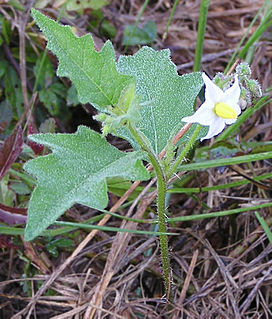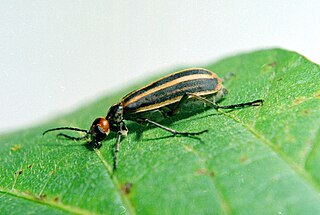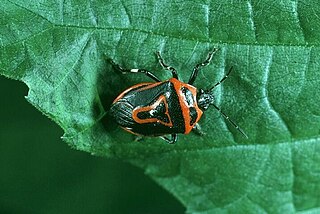
The potato is a starchy tuber of the plant Solanum tuberosum and is a root vegetable native to the Americas. The plant is a perennial in the nightshade family Solanaceae.

The Colorado potato beetle, also known as the Colorado beetle, the ten-striped spearman, the ten-lined potato beetle, or the potato bug, is a major pest of potato crops. It is about 10 mm long, with a bright yellow/orange body and five bold brown stripes along the length of each of its elytra. Native to the Rocky Mountains, it spread rapidly in potato crops across America and then Europe from 1859 onwards.

Solanum carolinense, the Carolina horsenettle, is not a true nettle, but a member of the Solanaceae, or nightshade family. It is a perennial herbaceous plant, native to the southeastern United States. The plant is invasive throughout much of temperate North America, as well as parts of Europe, Asia, and Australia. The stem and undersides of larger leaf veins are covered with prickles.

The tansy beetle is a species of leaf beetle. It measures 7.7–10.5 mm in length and has a characteristic bright metallic green colouration. The common name derives from the tansy plant on which they often feed as both larvae and adults. In addition to the nominotypical subspecies, which repeats the specific name, C. graminis graminis, there are five further distinct subspecies of tansy beetle, which, collectively, have a Palearctic distribution, although in the majority of countries where it is found the species is declining. In the United Kingdom it is designated as 'Nationally Rare' and this localised population, centred on York, North Yorkshire, has been the subject of much recent research.

Leptinotarsa is a genus of leaf beetles.

Cleridae are a family of beetles of the superfamily Cleroidea. They are commonly known as checkered beetles. The family Cleridae has a worldwide distribution, and a variety of habitats and feeding preferences.
Globodera pallida is a species of nematode in the family Heteroderidae. It is well known as a plant pathogen, especially of potatoes. It is "one of the most economically important plant parasitic nematodes," causing major crop losses, and is a model organism used to study the biology of cyst nematodes. Its common names include potato cyst nematode, white potato cyst nematode, pale potato cyst nematode, potato root eelworm, golden nematode, and pale cyst nematode.

Peridroma saucia, the pearly underwing or variegated cutworm, is a moth of the family Noctuidae. The species was first described by Jacob Hübner in 1808. It is found in North and South America, Europe, Asia and Africa. The variegated cutworm feeds on many plants, especially common fruits and vegetables. The moth undergoes two to four generations per year. The development of the moth slows in colder temperatures, indicative of its migratory nature. All stages of the life cycle have a developmental threshold for temperature. The moth is known to migrate to the northern regions during warmer months, returning to the southern regions when the climate becomes colder.

Solanum rostratum is a species of nightshade that is native to the United States and northern and central Mexico. Common names include buffalobur nightshade, buffalo-bur, spiny nightshade, Colorado bur, Kansas thistle, bad woman, Mexican thistle, and Texas thistle.

Coleomegilla maculata, commonly known as the spotted lady beetle, pink spotted lady beetle or twelve-spotted lady beetle, is a large coccinellid beetle native to North America. The adults and larvae feed primarily on aphids and the species has been used as a biological control agent. Based on name connotation and to avoid confusion with other species also called "spotted ladybeetle", spotted pink ladybeetle is probably the most appropriate common name for this species.

Lebia grandis is a ground beetle in the family Carabidae found in North America. It is a specialist predator on the eggs and larvae of Colorado potato beetles, and its larvae are obligate parasitoids of Colorado potato beetle pupae.
Leptinotarsa haldemani is a glossy green beetle in the family Chrysomelidae. It is commonly known as Haldeman's green potato beetle. It was named in honour of Samuel Stehman Haldeman, a 19th-century American entomologist who collected insect specimens in Texas.

Solanum chacoense is a species of wild potato. It is native to South America, where it can be found in Brazil, Bolivia, Argentina, Peru, Uruguay, and Paraguay. It "is one of the most widely distributed wild potato species." It grows as a common weed in disturbed habitat such as crop fields. It can also be found in Australia, China, the United States, England, New Zealand, and elsewhere as an introduced species.

Papuaepilachna guttatopustulata, the large leaf-eating ladybird, is a species of ladybird, formerly in the genus Henosepilachna endemic to parts of Australasia, specifically New South Wales, Queensland, the Bismarck Archipelago, New Guinea, New Hebrides and Solomon Islands.

Gratiana boliviana is a species of beetle in the leaf beetle family, Chrysomelidae. Its common name is tropical soda apple leaf beetle. It is native to South America, where its distribution includes Argentina, Brazil, and Paraguay. It specializes on tropical soda apple, an invasive plant species. It has been released as an agent of biological pest control against the weedy plant in Florida and other parts of the United States.

Epicauta vittata is a species of beetle in the family Meloidae, the blister beetles. It is native to eastern North America, including eastern Canada and the eastern United States. It is known commonly as the striped blister beetle and the old-fashioned potato beetle. It is known as an agricultural pest.

Perillus bioculatus, the two-spotted stink bug or double-eyed soldier bug, is a species of insect in the family Pentatomidae. They are native to North America but have been introduced to Eastern Europe and North India. Both the larval and adult stages are specialized predators of eggs and larvae of the Colorado potato beetle. However, the first instar larvae feed by sucking the juices out of potato stems.
Henosepilachna vigintioctomaculata is a species of beetle in the family Coccinellidae. It is commonly known as the 28-spotted potato ladybird, a name also used for the closely related species, Henosepilachna vigintioctopunctata.
Trichobaris trinotata, commonly known as the "potato stalk borer", is a species of weevil in the family Curculionidae. It is found in North America where it is a pest of potato plants, the larvae tunnelling inside their stems.

Rhogogaster viridis, common name green sawfly, is a species of common sawfly in the family Tenthredinidae.















